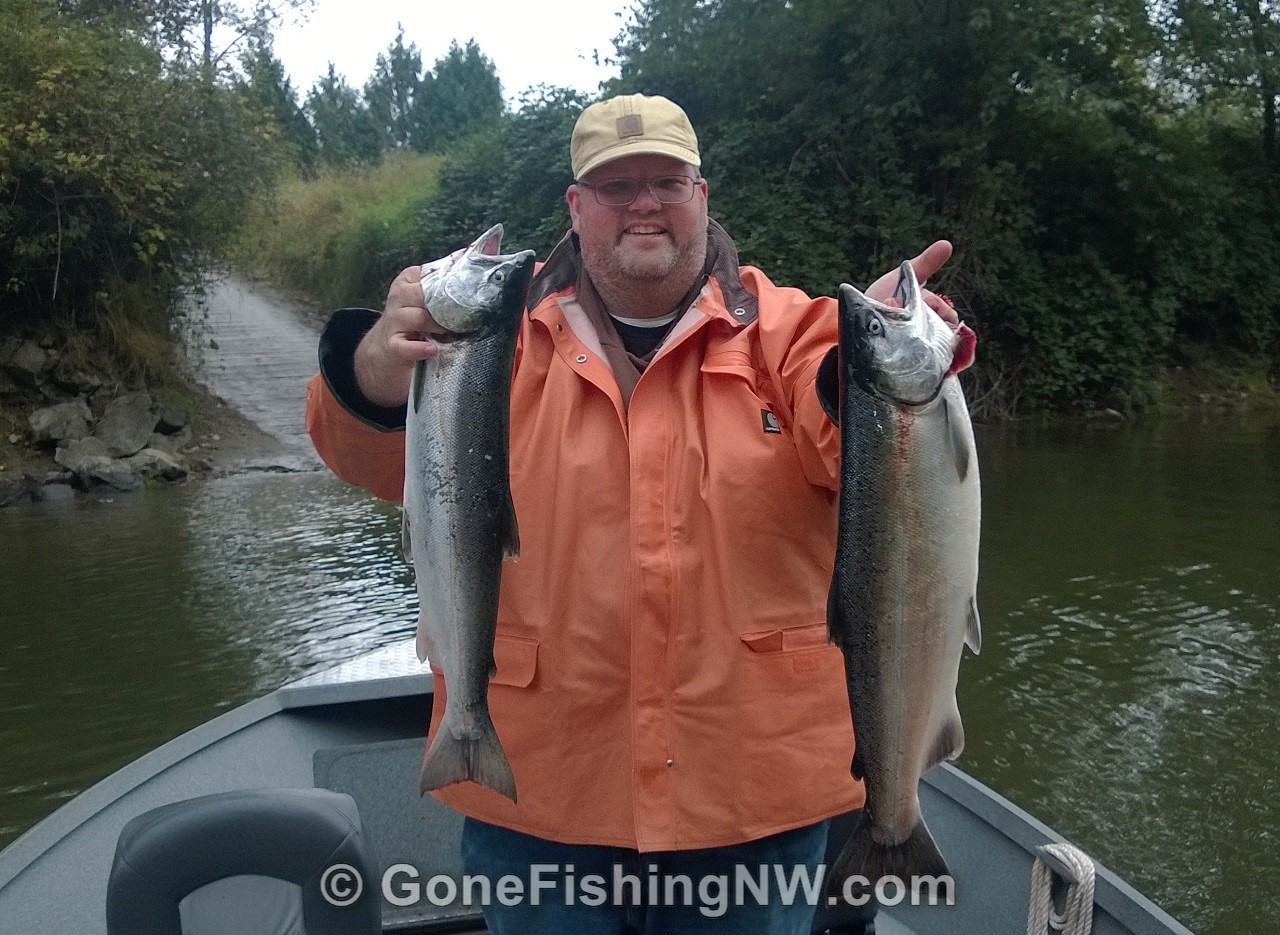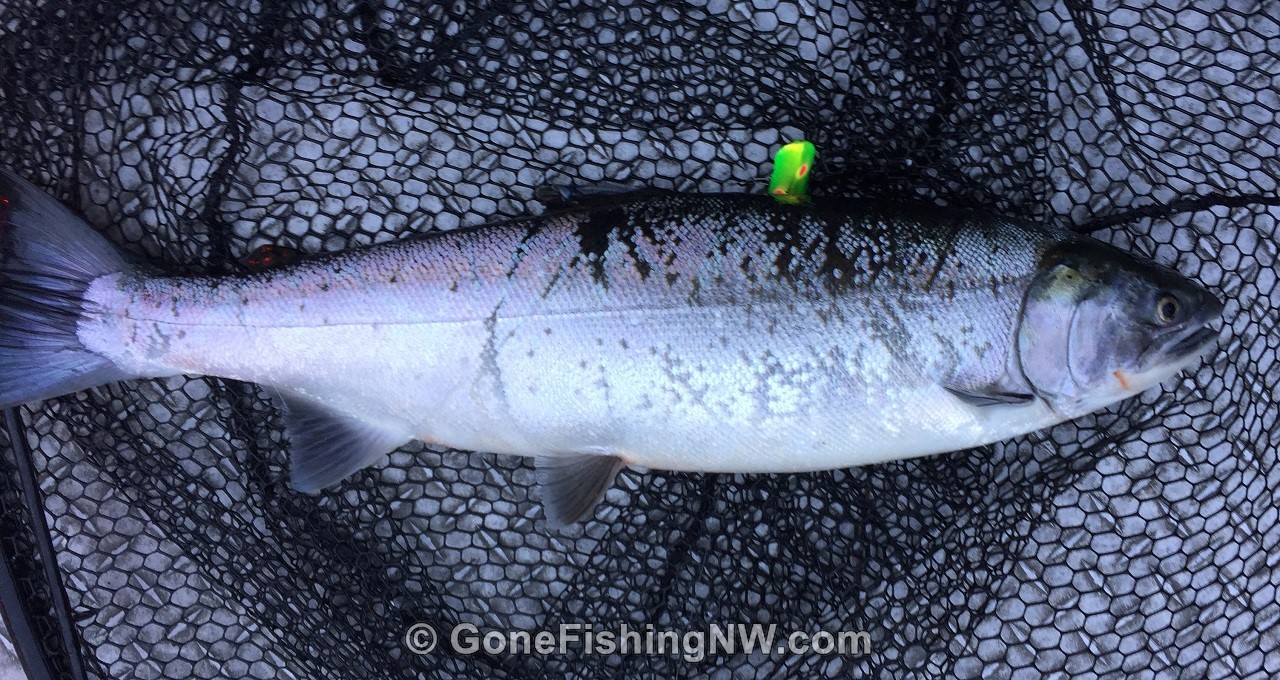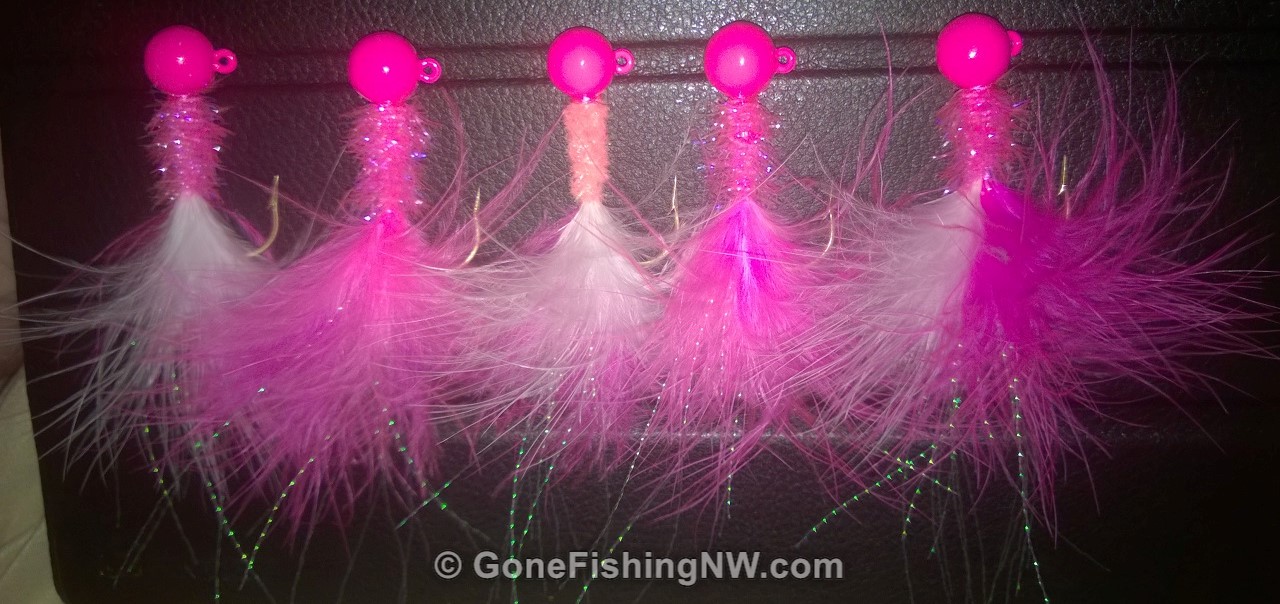Search
Latest Articles
Coho River Fishing Primer
by Nathan Nesbit of GoneFishingNW.com, October 01, 2016
Whenever and wherever you will be fishing for coho it is good to be prepared, so you can maximize your catching when out on the water.
This primer is an excerpt from my full length guide for coho salmon river fishing, which is on GoneFishingNW.com
About Coho
Coho salmon, also known as silver salmon or just silvers, start their life hatching from their eggs in late winter or early spring. Even after hatching they spend six to seven more weeks in the redd, growing from the nutrients in the egg sack.
Unlike some other species, the immature coho spend considerable time in freshwater before migrating to the ocean. At least one year, maybe two, are spent in the river or off channel pools and tributaries before their outward migration. When the time comes they move to salt water in late spring to early summer.
Due to this extended period of time in the river they are more greatly impacted by habitat issues, compared to other species like Pink Salmon and Chum Salmon, which migrate quickly out to sea.
Once in the ocean they focus on feeding and growing. Then at two to three years of age they migrate back to the rivers to spawn.

Hide Or Seek
Before we can catch coho we must first know where they are – otherwise we would be fishing blind and wasting our time.
When we think about salmon returning to the river to spawn, there are only two type of water – traveling water and holding water. In each case identifying where to fish, and how to fish are different. If it isn’t holding water or traveling water, then it is unlikely you’ll find many fish there.
Obviously as salmon travel upstream to spawn, they must swim through water that is just between them and their objective. That is traveling water. It is the water the fish focus on just getting from A to B. When fishing traveling water your goal is to keep your gear in the travel lane enough that it intersects with a upstream moving fish.
Typical coho holding water is called “frog water” or “froggy.”
Essentially this is water with little to no current, often with a deeper pool in it. Such areas include the water behind points, back eddies, inside bends with deeper water, side channels and around structure like boulders or downed trees.
Best Conditions To Fish
When should we fish? Whenever we can, of course! But if we are lucky enough to pick and choose our fishing times, then we can optimize our chances for success.
Ideally we want to fish when the weather has been stable for a couple of days, as fluctuations can hurt the bite.
We also need to consider water conditions. Fishing when the water is rising or has just crested is usually when fishing is tough. Water that has been stable for a couple days, or is dropping, creates the conditions for better fishing. Fortunately the USGS has gauge stations on the major rivers and reports that data in near real time online.
Plug It!
I’ve caught more coho on plugs than any other lure, and it is by far my favorite lure. Plugs is a generic term for a lure, usually made from plastic, which has a wiggle action and dives when pulled through the water. There are several brands and styles. The most popular ones these days are Brad’s Wigglers and Maglips – however all brands and styles catch fish and everyone has their favorites.
Many of the colors have funny names like Blue Pirate, Mad Clown, Red Devil, Dr Death and Fish Monger. Generally speaking colors with florescent red, florescent orange or chartreuse are good for all purposes. Blacks and purples also have their time and place.
If you are targeting holding water then the best way to fish a plug is to cast it. You can do this from either boat or bank. Simply cast a bit upstream and past the fish. Reel in fast enough so the lure dives and has a good wiggle. The fish will hit the plug hard, and you will have no doubt it is time to set the hook.

Spoon Man
Another great way to target coho is with spoons, especially Dick Nite Spoons. These small and light spoons flutter with the slightest current and drive the fish nuts. In the hands of a master these little things can put fish after fish in the cooler.
They come in a few different sizes and colors. For coho I usually use the smallest size, the size 0, but occasionally use the size 1. For colors think along the same lines as the plug colors – pinks and reds. However 50/50 and Nickle Back Frog are also very popular colors.
Regardless if you are fishing from a boat or the bank, drifting fishing the spoon is the way to go. Rigging instructions for drift fishing a dick nite spoon is available on GoneFishingNW.com
This can be fished in either holding water or traveling water. In either case cast straight out. Allow the lure time to sink to bottom. Then slowly retrieve while the current swings it downstream. The speed of the retrieve depends on the current. If the current is fast then reel slow, if the current is slow then reel faster.
You should feel the weight tap bottom every 2 to 3 seconds. If it is more often then you have too much weight. If it is less frequent, then add weight. The bite is usually a quick tug, so be ready to set the hook.
Roe Roe Roe Your Boat
Roe, which is just a fancy name for salmon eggs, is also an effective bait. There are lots of theories as to why, but the reality is no one really knows why salmon would bite on salmon eggs.
If you are like me you also like the thrill of seeing a bobber shoot underwater, as a fish takes your bait. That is one of the things that makes float fishing so much fun. This is really great in slow or even still holding water, as the float will keep the roe in position for a long time.
Set your float up with a bobber stop, then the bead, the float, and lastly a weight. Finish it off with a snap swivel to keep everything on the mainline. Then prepare a leader with a size 4 octopus hook, tied with an egg loop knot. I usually use about 3 feet of leader. Use a chunk of roe about the size of a quarter, and put it in the egg loop.
Set your bobber stop so that the roe will be suspended about 6 inches above the bottom of the river. If you don’t know the depth then make a guess. On each cast increase the depth set by about 1 foot, until the top of the bobber points downstream while drifting - indicating the roe is dragging on bottom. Then shorten it up until you get a good float again.
In slow or still water you can cast out and just wait for the bobber to go under. In faster water you want to keep the line off the water as much as possible and gradually let out line so the float has a “drag free drift”. Then reel in and do it again. This is great for beginners because strikes are so visible and definitive.
Master The Twitch
The last technique I’ll cover is twitching jigs. This is a great technique for holding water.
There are a lot of jigs on the market, but you’ll want one which is designed for twitching. A twitching jig has a long tail, which provides a lot of movement in the water. I like to tie my own, since commercial choices can be limited. Stick with the typical coho colors – red, orange, pink and purple. 1/4 ounce to 1/2 once work for most conditions.'

To fish it, cast your jig out from you. Count down until it is close to bottom. Then quickly jerk the rod up – moving the tip about one foot. Lower the rod back down at a moderate speed, taking in just enough line to avoid creating slack in the line.
The fish often hit on the drop, so if the lure stops dropping then set the hook. Often you’ll notice the fish on the next jig up. Always be prepared to follow through with a hookset.
Respect Your Catch
After you catch your fish, make sure to handle it well to ensure it will make the best table fare.
Stun the fish with a fish bonker, or even a nearby rock. With the fish subdued you will want to bleed it out. This is easily done by cutting, or pulling out, the gills. The blood will then pump out. While this is going on, most people prefer to have the fish in a stringer or in a fish box.
After a few minutes it should be bled out. If fishing on a boat make sure you have a cooler with ice and transfer the fish into the cooler to keep it cool for the rest of the day. If you are on the bank and couldn’t pack a cooler, then you may have to leave it in the water. Consider packing it back to the car soon, as while the water may feel cold to you, it really isn’t near as cold as your refrigerator.
Go Catch Some Fish
I hope this information helps you catch more fish. For more information about fishing for coho (and other species) and places to fish, please go to GoneFishingNW.com
Tight Lines!



